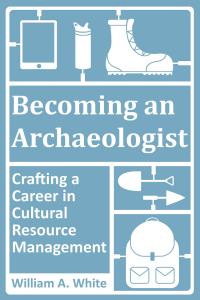 (This is part of a new and ongoing series called Thor’s Day Cultural Resource Management Archaeology Hacks. Quick as lightning, these tips are designed to help you make the impact of Mjölnir on your next project.)
(This is part of a new and ongoing series called Thor’s Day Cultural Resource Management Archaeology Hacks. Quick as lightning, these tips are designed to help you make the impact of Mjölnir on your next project.)
It happens in Arizona each summer. Somebody, and it isn’t always a tourist, decides to do a hike in the desert during the hottest part of the day. They succumb to the heat. Some are rescued. Others die after a rescue. A few die before they can be found. Each of these deaths is tragic. Each one is preventable.
Something else happens every single day in Arizona during the summer. All across the state, hundreds of employees work in the same heat—frequently on the same day when somebody elsewhere dies—and they come home safe and sound to complain about how hot it was out there that day. Construction workers, police officers, landscapers, cultural resource management archaeologists, and workers in a lot of other professions pull long hours out in the same sun that kills other people.
The difference is these workers know how to work safely in the heat. They don’t survive because they’re stronger or better equipped. They aren’t born with an evolutionary advantage. The reason why they do not die is because they work safely in extreme temperatures long enough for their bodies to acclimate to it.
Smart employees take precautions, stay hydrated, and pay attention to their bodies. Working in extreme temperatures is not fun, but most people can do it if they stay safe.
I’ve said it before and I’ll say it again
Heat-related injuries are no joke. They shorten your career and can shorten your lifespan. Your brain is a very sensitive organ. If it gets too cold or too hot, it will stop working. Without a brain you are not alive.
In 2013, I wrote a blog post and created a 9-page worksheet for archaeologists who find themselves working in hot weather. This week, episode 87 of the CRM Archaeology Podcast addressed summer health and safety issues including dehydration and working in extreme heat. I urge every archaeologist and archaeology student to check out these resources in order to learn some best practices for working in extreme heat.
The topic remains on my mind as the Sonoran Desert summer kicks in. Last weekend, four hikers died in Tucson because they ventured out into the desert for a little exercise. Temperatures peaked at 115 degrees and the victims—including two tourists from Germany—were unable to withstand those temperatures. The saddest thing is the fact that these people did not have to be out in the sun. They chose to go out and suffered dire consequences.
Cultural resource management archaeologists do not have a choice about working out in extreme heat unless they want to quit their jobs. But, we can choose to be smart about it. I know co-workers who conducted an archaeological survey near Baghdad, Arizona when the mercury topped 120 degrees for three days in a row! I’ve worked with others who had to dig without shade in those same temperatures. More than once I have lead crews out into the desert on days where it was well over 110 degrees. We all lived to tell the tale of those horrible projects because we took proper precautions and listened to what our bodies were telling us.
Get used to doing archaeology in hot weather
Archaeologists work in extreme environments around the world, including scorching hot deserts and jungles. Fortunately, the human body has a similar response to heat-related illnesses. Unfortunately, everybody is different. Each of us has a different breaking point when it comes to too much heat.
While there is no way of knowing when we’ll reach the breaking point, there are several standard precautions we can take (NOTE: All of these are covered in greater detail in the aforementioned PDF worksheet. Download it for free today):
1) Stay hydrated—Keep taking small sips of water every 2-3 minutes. Make sure to keep drinking water after you’ve returned home or back to your hotel room. Try not to drink too much coffee, alcohol, soda, or other dehydrating beverages when you know it will be very hot the next day.
2) Listen to your body—Know the signs of dehydration and heat illness. Everybody is different but, generally, you will start to notice that your brain is working slower than usual when it gets too hot. That’s a sign that you need to take action. Get some shade, a cool rag or ice on your neck, or take a break.
You are in serious trouble if you have a headache or start to feel dizzy. That’s a sign that your brain is shutting down or you are dehydrated. Don’t tough it out. Take action immediately.
3) Pay attention to your co-workers—Do you want to haul a 220-pound man across the open desert to the truck? Even worse, do you want to attend their funeral? Probably not.
Taking care of yourself also means taking care of others. Make sure you notice the warning signs of heat illness and dehydration on other people—pale skin, no longer sweating, incoherency, or puffy red skin. Make sure your co-workers are drinking water and taking breaks.
4) Get acclimated—The best way to survive working in extreme heat is by getting used to it. I have my own method, which involves jogging, biking, or doing yard work in sequentially hotter parts of the day until I can handle strenuous activity in 100+-degree temperatures for at least an hour or so. This may not be suitable for other people. You can start with 10 to 15 minute walks out in the mid-day sun as a way of gauging how your body responds with the goal of working up from that. Regardless of where you begin, you need to be outside in the heat if you ever expect to be able to work in it.
5) Wear the right gear—Of course PPE, backpacks, and other items can diminish your ability to handle the heat, but you should do your best to wear the right clothing for working in extreme heat. Light colors, loose-fitting garments, and a wide-brimmed hat are best. Full body coverage is also good, but I know a lot of people who prefer working in short sleeves. That is okay as long as you understand the long-term risks of extreme sun exposure. The same goes for sun glasses, sunscreen, and gloves, which can help prevent harmful rays from damaging your skin.
Tan pants, a light-colored long sleeved dress shirt, polarized ANSI Z87 safety glasses, a bandana, and a straw cowboy hat are my usual field garb during the summer. Each person is different but something along these lines are typically what we wear down here in the desert. Wearing proper gear will help prevent you from overheating and keep your skin shaded from direct contact with the blistering sun.
Working in the summer sun can be hazardous but it can also be a necessity. Please, help other cultural resource management archaeologists stay safe by learning how to work in extreme heat. Also, download the PDF “Hot Weather Health and Safety Tips” for some excellent tips on how you can stay safe out there this summer.
What else did I miss. Tell us. Write a comment below or send me an email.
 Having trouble finding work in cultural resource management archaeology? Still blindly mailing out resumes and waiting for a response? Has your archaeology career plateaued and you don’t know what to do about it? Download a copy of the new book “Becoming an Archaeologist: Crafting a Career in Cultural Resource Management” Click here to learn more.
Having trouble finding work in cultural resource management archaeology? Still blindly mailing out resumes and waiting for a response? Has your archaeology career plateaued and you don’t know what to do about it? Download a copy of the new book “Becoming an Archaeologist: Crafting a Career in Cultural Resource Management” Click here to learn more.
Check out Succinct Research’s contribution to Blogging Archaeology. Full of amazing information about how blogging is revolutionizing archaeology publishing. For a limited time you can GRAB A COPY FOR FREE!!!! Click Here
 “Resume-Writing for Archaeologists” is now available on Amazon.com. Click Here and get detailed instructions on how you can land a job in CRM archaeology today!
“Resume-Writing for Archaeologists” is now available on Amazon.com. Click Here and get detailed instructions on how you can land a job in CRM archaeology today!
 Small Archaeology Project Management is now on the Kindle Store. Over 300 copies were sold in the first month! Click Here and see what the buzz is all about.
Small Archaeology Project Management is now on the Kindle Store. Over 300 copies were sold in the first month! Click Here and see what the buzz is all about.
Join the Succinct Research email list and receive additional information on the CRM and heritage conservation field.
Get killer information about the CRM archaeology industry and historic preservation.




Perfect list. This is exactly what I tell my coworkers. I try to check in verbally with my coworkers often so I can tell when they’re starting to sound tired or otherwise off. I also encourage people to take as many breaks as they need. Working outside in 110+ degrees is not the time to show off and show everyone how tough you can be.
I recommend acquiring a 100 oz (3L) hydration daypack (not a big backpack, but one designed to accommodate the hydration plus a few tiny pockets.) – In the morning of a hot day, add 3/4 ice and 1/4 water. It will melt through the day and cool your back while providing clean cool water through the mouth piece. I even use a small bit of lemonade drink flavoring. I carry two filled bladders in a cooler and usually just finish the last one by around 5-7pm.
Mine is a camelbak MULE ($175) and I’ve used it for over 10 years. I have a cleaning brush and drying hangers I’ve made from some plastic coathangers. Some small packs available for less money I’m sure, but the key is NOT to try to make it your primary pack – because you’ll then oversize it and it’ll become ungainly around the site. The MULE is made for mountain bikers so is rather low profile.
I hope this is helpful.
it is thoroughly helpful. Thank you for posting this. I’ve looked at the MULE before but will give it a serious look in the future. thanks for the recommendation